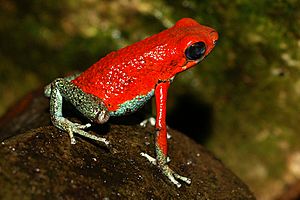Granular poison frog facts for kids
Quick facts for kids Granular poison frog |
|
|---|---|
 |
|
| Conservation status | |
| Scientific classification | |
| Synonyms | |
|
The granular poison frog (Oophaga granulifera) is a small, brightly colored frog. It belongs to the Dendrobatidae family, also known as poison dart frogs. You can find this frog in the warm, wet forests of Costa Rica and Panama. It was first named Dendrobates granuliferus in 1958. Later, in 1994, scientists moved it to the Oophaga group. Sadly, its home is shrinking, which puts this amazing frog at risk.
Contents
About the Granular Poison Frog
The granular poison frog is quite small. It usually grows to about 20 millimeters (less than an inch) long. Its skin feels a bit bumpy, like tiny grains. Most of these frogs have a bright orange head, body, and upper arms. Their lower arms, legs, and belly are often a bluish-green color.
In some parts of Costa Rica, near a place called Quepos, you might see a different color. Here, the orange parts of the frog are olive green instead. This shows how animals can have different looks even within the same species.
Where Granular Poison Frogs Live
This special frog lives in the countries of Costa Rica and Panama. Its home stretches from the southwest of Costa Rica into the nearby areas of southwestern Panama. They live in places that are not very high up, usually less than 100 meters (about 330 feet) above sea level. You can also find them in Piedras Blancas National Park in southeastern Costa Rica.
These frogs love the floor of humid, low-lying forests. They spend their time among the fallen leaves on the ground. This leaf litter provides them with shelter and a place to hunt for food.
Life Cycle and Behavior
The granular poison frog is active during the day. It spends its time on the forest floor. When it's time to have babies, usually during the rainy season, the female frog lays a few eggs. She places groups of three or four eggs in safe spots. These spots can be curled-up dead leaves, under stones, or even in the forks of small branches. Sometimes, they lay eggs in the leaves of plants like bromeliads, just above the ground.
The male frog takes care of the eggs. He makes sure they stay moist until they hatch. Once the tiny tadpoles hatch, the female frog carries each one, one at a time. She moves them to small pools of water. These pools can be in hollows of trees, in the leaves of plants like Dieffenbachia, or inside bromeliads. These water spots are usually a meter or two off the ground. The water in these tiny pools is very small, often only about 2.4 milliliters (less than half a teaspoon).
The female frog doesn't stop there! She keeps feeding her tadpoles. She does this by laying unfertilized eggs into the water where the tadpoles are. The tadpoles then eat these eggs to grow.
Warning Signals and Defense
The granular poison frog is known for its bright colors. These colors are a warning sign to other animals. This is called being aposematic. It means "stay away, I'm poisonous!" The frog uses its poison only to protect itself from predators. It's a defense mechanism, not something they use to hunt.
Studies in Costa Rica show that male granular poison frogs spend a lot of time and energy defending their territory. They use sounds more than their bright colors to warn other males. If another male frog gets too close, they might even get into a fight!
Status of the Granular Poison Frog
The IUCN (International Union for Conservation of Nature) has listed this frog as "Vulnerable". This means it's a species that could become endangered if things don't change. The main reasons for this status are:
- Its natural home is quite small.
- The number of these frogs seems to be going down.
- Its rainforest habitat is being destroyed.
Protecting these forests is very important to help the granular poison frog survive.
See also
 In Spanish: Oophaga granulifera para niños
In Spanish: Oophaga granulifera para niños


